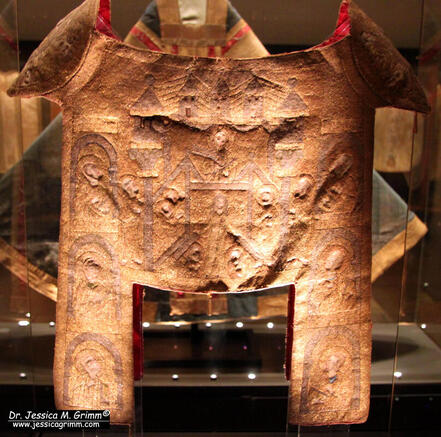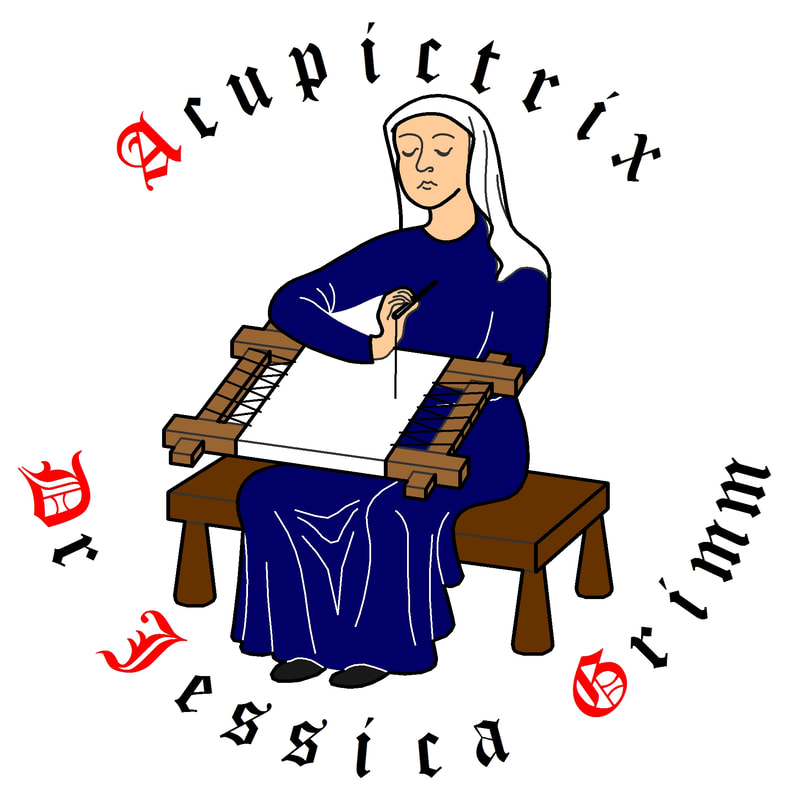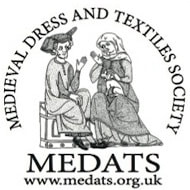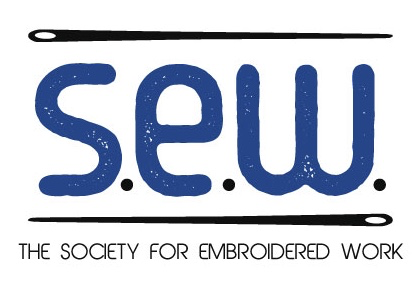|
Let's explore last week's rationale a bit more. This rare medieval vestment is modelled on the ephod of the Jewish high-priest. Chapter 28 of the bible book Exodus described the garments that need to be made by skilled craftsmen for Aaron and his sons in great detail. Verses 6-14 tell us about the design of the ephod: "And they shall make the ephod of gold, and violet, and purple, and scarlet twice dyed, and fine twisted linen, embroidered with divers colours. It shall have the two edges joined in the top on both sides, that they may be closed together. The very workmanship also and all the variety of the work shall be of gold, and violet, and purple, and scarlet twice dyed, and fine twisted linen. And thou shalt take two onyx stones, and shalt grave on them the names of the children of Israel: Six names on one stone, and the other six on the other, according to the order of their birth. With the work of an engraver and the graving of a jeweller, thou shalt engrave them with the names of the children of Israel, set in gold and compassed about: And thou shalt put them in both sides of the ephod, a memorial for the children of Israel. And Aaron shall bear their names before the Lord upon both shoulders, for a remembrance. Thou shalt make also hooks of gold. And two little chains of the purest gold linked one to another, which thou shalt put into the hooks." (Douay-Rheims Bible which is closest to the Vulgate Latin version widely used in medieval Europe). The text makes clear that the ephod was a very precious garment with gold, gemstones and costly dye-stuffs. And it also explains the shape of the medieval rationale with the two patches on the shoulders. The name "rationale" is derived from the translation of the priest's ephod (Hebrew), to logion (Greek) into rationale (vulgate Latin) (Miller 2014, 64). Who was allowed to wear a rationale? Bishops were allowed to wear the rationale over the chasuble. Although it seems that this special vestment was sometimes granted by the pope to a particular bishop (Pope Agapetus II apparently granted one to the see of Halberstadt, Germany, before AD 984) other bishops simply copied its use. It became fashionable in the 11th- and 12th- century in Germany and then spread to France and England in the 13th-century. Curiously, Italian bishops, with the exception of the sees of Aquileia and Monreale, do not seem to have been keen on wearing it (Miller 2014, 65-66). Presently, only the bishops of Eichstätt and Paderborn (Germany), Toul-Nancy (France) and Krakow (Poland) wear this medieval vestment on special occasions. The rationale from Bamberg belongs to the so-called Kaisergewänder (held at the Diözesanmuseum Bamberg) and was made between AD 1007 and 1024 in the realm of Holy Roman Emperor Henry II. The embroidery is made with very fine, near-pure goldthreads in normal couching on dark-blue silk samite imported from the Byzantine Empire. Although presently the embroidery is applied to a bell-chasuble made of blue Italian silk damask from AD 1450, the original embroidery was also part of a bell-chasuble rather than a separate vestment such as the Regensburger rationale. The embroidery depicts scenes from the Apocalypse, an allegory of the church and busts of the apostles (Kohwagner-Nikolai 2020, 190-196). The rationale from Regensburg (part of the Regensburger Domschatz) was made in AD 1314/1325, possibly in Regensburg (Germany). It was made at the behest of king, and later Holy Roman Emperor, Louis IV, called the Bavarian (AD 1282-1347). He gifted it to bishop Nikolaus von Ybbs (AD 1270/1280-1340), bishop of Regensburg. It is made of linen embroidered with very fine gold- and silver threads as well as silks. On the front, we see an allegorical depiction of the church. On the back, we see Christ in the mandorla surrounded by angels, symbols of the evangelists and the agnus dei. The elongated slips on the front and the back contain the busts of the apostles. The two shields on the shoulders contain female allegories of Psalm 85:10. Each depiction can be identified by stitched texts in either Latin or German (Kohwagner-Nikolai 2020, 237-240).
For a detailed description of the embroidery techniques and materials used for both rationale, we will have to wait for the publication of the research project results of the "Kaisergewänder", later this year. Literature Kohwagner-Nikolai, T., 2020. Kaisergewänder im Wandel - Goldgestickte Vergangenheitsinszenierung. Regensburg: Schnell & Steiner. Miller, M.C., 2014. Clothing the clergy. Cornell University Press.
12 Comments
Debbie
22/3/2021 12:20:00
Hi Jessica , once again I am blown away by these precious pieces of hand embroidery .
Reply
22/3/2021 12:30:44
Hmm, I am not sure. These pieces have such a long genesis that without detailed scientific research it is near impossible to untangle the different stages of their alteration from the stitching on the front allone. These red stitches do look a bit suspicious (as do some of the black and blue outlines).
Reply
Darcy Walker
22/3/2021 14:34:13
What extraordinary garments. Thank you for sharing.
Reply
23/3/2021 09:29:52
Oh yes, full attire was rather heavy. There was a video of the tallest curator of the museum wearing these pieces as they are being transported from the depot to the exhibition rooms and he confirms that they are heavy and warm.
Reply
Kathrine
22/3/2021 22:41:20
Hello and thankyou for having such interesting posts. The faces here are so expressive and individual. I'm wondering why the scarlet was twice dyed. I know nothing about scarlet dye of the age.
Reply
23/3/2021 09:32:12
Thank you Kathrine. I assume they dyed the cloth twice to get a deeper red. Achieving bright colours was rather difficult and dying cloth multiple times to achieve a deeper colour was the norm. This made the cloth more expensive too.
Reply
Valerii
28/6/2022 12:36:10
Good afternoon, Jessica! Thank you for a wonderful story about Rational. I am delighted with these majestic treasures, which are so well preserved. Bamberger rationale is generally a revelation for me. It seems to me that its back side (Bamberger rationale) is almost identical to Rationale from Pommersfelden?
Reply
28/6/2022 12:59:27
Dear Valerii,
Reply
Valerii
28/6/2022 13:31:27
Thank you, Ms. Jessica, for your quick response. You are a happy person if you have seen these treasures in their natural form. I saw only from your photos. I am a designer of liturgical clothes and a master of micro-embroidery. The last embroidered rational for Bishop Gregor Maria Hanke of Eichstätt is my work. My name is Valery Malinovskiy - I'm from Ukraine. If you please, direct me to the museum you mentioned, maybe an e-mail or a FB profile. 28/6/2022 13:59:40
Wow, embroidering vestments for current clergy is very prestigious! Her name is Carola Marie Schmidt and you can find her contact details here: https://dioezesanmuseum-bamberg.de/kontakt/team/ Your comment will be posted after it is approved.
Leave a Reply. |
Want to keep up with my embroidery adventures? Sign up for my weekly Newsletter to get notified of new blogs, courses and workshops!
Liked my blog? Please consider making a donation or becoming a Patron so that I can keep up the good work and my blog ad-free!
Categories
All
Archives
July 2024
|
Contact: info(at)jessicagrimm.com
Copyright Dr Jessica M. Grimm - Mandlweg 3, 82488 Ettal, Deutschland - +49(0)8822 2782219 (Monday, Tuesday, Friday & Saturday 9.00-17.00 CET)
Impressum - Legal Notice - Datenschutzerklärung - Privacy Policy - Webshop ABG - Widerrufsrecht - Disclaimer
Copyright Dr Jessica M. Grimm - Mandlweg 3, 82488 Ettal, Deutschland - +49(0)8822 2782219 (Monday, Tuesday, Friday & Saturday 9.00-17.00 CET)
Impressum - Legal Notice - Datenschutzerklärung - Privacy Policy - Webshop ABG - Widerrufsrecht - Disclaimer







 RSS Feed
RSS Feed